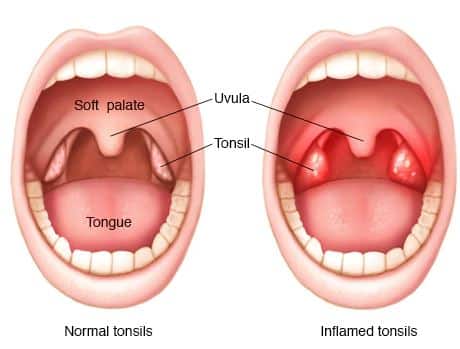Tonsillectomy Complications – Overview
Tonsillectomy is the surgical removal of the palatine tonsils from the back of the throat. The palatine tonsils can often be seen as a flesh-colored, pinkish lump at the back of the throat. The tonsils appear whitish when they become inflamed or infected.

The tonsils help to augment the body’s immunity by providing immunity against invading micro-organisms in the body. As a result of the immune function, the tonsils tend to become inflamed while defending the body resulting in a condition known as tonsillitis with symptoms such as sore throat, fever and difficulty swallowing.
For those with frequent throat infections, surgical removal of the tonsils results in fewer sore throats in the following one to two years, but the long-term benefits are unclear.
While generally safe, complications of tonsillectomy may include bleeding, vomiting, trouble eating, and trouble talking.
Recovery time for a tonsillectomy is usually at least 10 days to two weeks.
Reasons for Tonsillectomy Surgery
The procedure is often performed to prevent frequent throat infections (tonsillitis) and obstructive sleep apnea.
Tonsillitis – This refers to the inflammation of the tonsils, typically of rapid onset. Symptoms may include sore throat, fever, enlargement of the tonsils, trouble swallowing, and large lymph nodes around the neck. Complications include peritonsillar abscess(quinsy).
In adults, tonsillectomy is not recommended for those with fewer than 7 throat infections in the last year. In children, the benefit of tonsillectomy is modest with evidence supporting the benefit in the first one or two years.
Obstructive Sleep Apnea – Obstructive sleep apnea (OSA) is the most common type of sleep apnea and is caused by complete or partial obstructions of the upper airway.
It is characterized by repetitive episodes of shallow or paused breathing during sleep, despite the effort to breathe, and is usually associated with a reduction in blood oxygen saturation. These episodes of decreased breathing, typically last 20 to 40 seconds.
Tonsillectomy improves obstructive sleep apnea (OSA) in most people. A 2015 Cochrane review found moderate-quality evidence for benefits in terms of quality of life and symptoms but no benefit in attention or academic performance.
It is recommended that physicians and parents should weigh the benefits and complications of tonsillectomy as OSA symptoms may spontaneously resolve over time.
More: History of Surgery
Complications of Tonsillectomy
Although tonsillectomy is generally a safe procedure, however, like every other surgical procedure, there are risks of complications during and after the procedure. Tonsillectomy complications are as follows:
1. Bleeding – There is always a risk of bleeding following surgery from the incision made by the surgeon.
An injury to a blood vessel can cause bleeding after surgery. Bleeding after tonsillectomy affects about 4% of children. Bleeding occurs in about 1% within the first day and another 2% after that.
2. Vomiting – The throat may be irritated during the procedure causing the patient to throw up. A single dose of the corticosteroid drug dexamethasone may be given during surgery to prevent postoperative vomiting.
3. Difficulty in Eating – Initially, the patient may experience difficulty in eating. This will resolve shortly after the procedure.
4. Trouble Talking – Another possible tonsillectomy complication is difficulty in talking.
5. Heart attack or stroke – There is also the risk of developing a heart attack or stroke following tonsillectomy. A blood clot from deep venous thrombosis that breaks off and travels through the body can cause a heart attack, or stroke by lodging in the heart, or brain.
6. Swelling – Swelling of the tongue and soft roof of the mouth (soft palate) can cause breathing problems, particularly during the first few hours after the procedure.
7. Damage to glossopharyngeal nerve – This is one of the tonsillectomy complications. The nerve helps to innervate the posterior 1/3rd of the tongue to provide taste sensation. This nerve is most likely to be damaged during a tonsillectomy, which leads to reduced or lost general sensation and taste sensation to the posterior third of the tongue.
8. Death – This is an extremely rare occurrence and death occurs as a result of between 1 in 2,360 and 56,000 procedures.

tonsillectomy complications
Tonsillectomy Surgery Cost
The total cost for tonsillectomy surgery depends on a lot of factors such as the anesthetic fee, private hospital fee, private operating facility fee, and the extent of surgery required. The total cost of tonsillectomy is around $5,000.
Tonsillectomy Recovery
Nearly everyone experiences pain after a tonsillectomy. Pain is most often in the throat and frequently in the ears but may also be located in the jaw or the neck.
Steps that you can take to reduce pain, promote recovery and prevent complications include the following:
Medications. Take pain medications as directed by your surgeon or the hospital staff.
Fluids. It’s important to get plenty of fluids after surgery to avoid dehydration. Water and ice pops are good choices.
Food. Bland foods that are easy to swallow, such as applesauce or broth, are the best choices immediately after surgery. Foods such as ice cream and pudding can be added to the diet if they’re tolerated. Foods that are easy to chew and swallow should be added to the diet as soon as possible. Avoid acidic, spicy, hard or crunchy foods as they may cause pain or bleeding.
Rest. Bed rest is important for several days after surgery, and strenuous activities — such as running and bike riding — should be avoided for two weeks after surgery.
You or your child should be able to return to work or school after resuming a normal diet, sleeping normally through the night and not needing pain medication. Talk to your doctor about any activities that should be avoided.
More: Surgery for Lung Cancer


